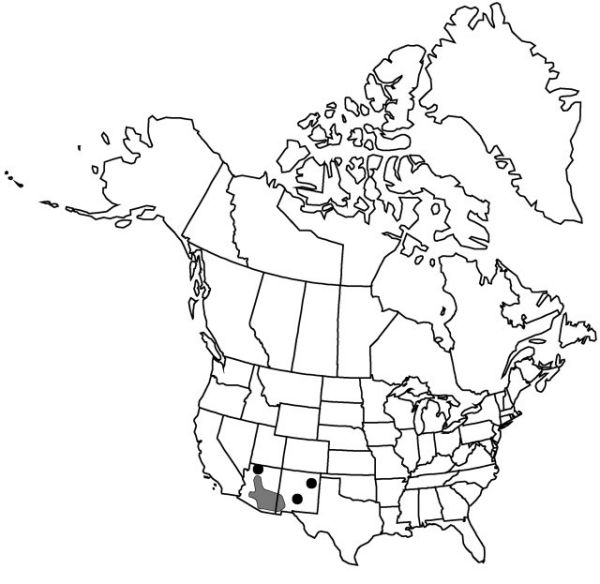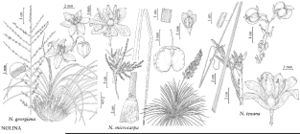Nolina microcarpa
Proc. Amer. Acad. Arts. 14: 247. 1879.
Plants acaulescent, cespitose; rosettes from vertical, subterranean, branched caudices. Leaf-blades wiry, lax, concavo-convex, 80–130 cm 5–12 mm, not glaucous; margins serrulate, with close-set, cartilaginous teeth; apex lacerate; inflorescence leaf-blades curling distally, 10–50 cm. Scape 3–15 dm, 1.2–2.5 cm diam. Inflorescences paniculate, 4–12 dm × 10–30 cm, surpassing leaves; bracts caducous, rarely persistent; bractlets 2–5 mm, slightly erose. Flowers: tepals white, 1.5–3.3 mm; fertile stamens: filaments 1.6–1.9 mm, anthers 1.2–1.4 mm; infertile stamens: filaments 0.9–1.2 mm, anthers 0.3–0.5 mm; fruiting pedicel erect, proximal to joint 1–2 mm, distal to joint 3–6 mm. Capsules hyaline, thin-walled, inflated, 4.2–6 × 5.4–6.4 mm, indistinctly notched at apex. Seeds loosely invested in capsules, compressed, 2.2–3.4 × 1.5–3 mm. 2n = 38.
Phenology: Flowering mid–late spring.
Habitat: Rocky hillsides, desert grasslands, oak and pinyon pine-juniper woodlands
Elevation: 900–1900 m
Distribution

Ariz., N.Mex., n Mexico
Discussion
D. S. Correll and M. C. Johnston (1970) included Nolina microcarpa in their flora of Texas; however, they reported that they had seen no specimen from that state, nor have I. This species is found primarily from western New Mexico through central Arizona. It forms large clumps up to 2 m in diameter and inflorescences that generally are exserted from the basal leaf rosettes. Considerable variation occurs, some of it geographically restricted to southeastern Arizona and southwestern New Mexico. Most such plants from the latter areas have been referred to N. texana or N. caudata, but are here included in N. microcarpa. In the Grand Canyon area, there are variants that have been referred to N. parryi because in width the leaves approach those of N. parryi and they are serrulate. These plants, however, are acaulescent and also are here included in N. microcarpa. B. J. Albee et al. (1988) reported N. microcarpa on rocky slopes in canyons in Washington County, Utah, but the more recent online version of that work excludes it from Utah.
Selected References
None.
Lower Taxa
"thick" is not a number. "thin" is not a number."dm" is not declared as a valid unit of measurement for this property."dm" is not declared as a valid unit of measurement for this property. "dm" is not declared as a valid unit of measurement for this property."dm" is not declared as a valid unit of measurement for this property."dm" is not declared as a valid unit of measurement for this property.
